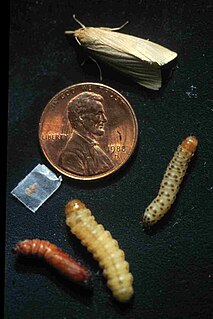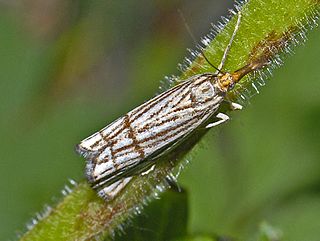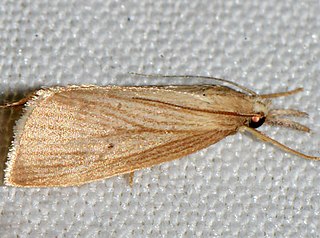
The Crambidae are the grass moth family of lepidopterans. They are variable in appearance, the nominal subfamily Crambinae taking up closely folded postures on grass stems where they are inconspicuous, while other subfamilies include brightly coloured and patterned insects which rest in wing-spread attitudes.

The Pyralidae, commonly called pyralid moths, snout moths or grass moths, are a family of Lepidoptera in the ditrysian superfamily Pyraloidea. In many classifications, the grass moths (Crambidae) are included in the Pyralidae as a subfamily, making the combined group one of the largest families in the Lepidoptera. The latest review by Eugene G. Munroe and Maria Alma Solis, in Kristensen (1999) retains the Crambidae as a full family of Pyraloidea.

The Pyraloidea are a moth superfamily containing about 16,000 described species worldwide, and probably at least as many more remain to be described. They are generally fairly small moths, and as such, they have been traditionally associated with the paraphyletic Microlepidoptera.
Caffrocrambus is a genus of moths of the family Crambidae.

Calamotropha is a genus of moths of the family Crambidae.

Culladia is a grass moth genus of subfamily Crambinae, tribe Crambini. Some authors have assigned the synonymous taxon Nirmaladia to the snout moth family (Pyralidae), where all grass moths were once also included, but this seems to be in error.
Gargela is a genus of moths in the subfamily Crambinae of the family Crambidae. The genus currently comprises 22 Austral-Asian species, of which the majority has been described in recent years. Many species remain to be described, with their total number probably being around 40 species.

Euchromius ocellea, the necklace veneer, is a moth of the family Crambidae described by Adrian Hardy Haworth in 1811. It is a widespread species, found in tropical and subtropical regions, but migrates to Europe.

Orocrambus flexuosellus is a species of moth in the family Crambidae. It was first described by Edward Doubleday in 1843. O. flexuosellus is endemic to New Zealand. It has been recorded from the North Island, South Island and the Stewart Islands. The species' habitat consists of lowland to alpine grasslands.

The southwestern corn borer, Diatraea grandiosella, is a moth belonging to the sub-order Heterocera. Like most moths, The southwestern corn borer undergoes complete metamorphosis developing as an egg, larva (caterpillar), pupa and adult. It is capable of entering diapause in its larva stage and under the conditions of a precise photoperiod. Growth and development are regulated by juvenile hormones. The southwestern corn borer has an extensive range. It occurs in Mexico and in Alabama, Arizona, Arkansas, Colorado, Illinois, Indiana, Kansas, Kentucky, Louisiana, Mississippi, Missouri, Nebraska, New Mexico, Oklahoma, Tennessee, and Texas.

Agriphila deliella is a species of moth of the family Crambidae. It is found in most of Europe and North Africa and from Anatolia to Afghanistan.

Diatraea crambidoides, the southern cornstalk borer moth, is a species of moth of the family Crambidae described by Augustus Radcliffe Grote in 1880. It is found in North America, from Alabama and northern Florida to Ohio and Maryland. Its wingspan is 15–40 mm, and adults are straw colored to dull white. The forewings are slightly darker than the hindwings. There are two generations per year.

Chrysocrambus linetella is a species of moth in the family Crambidae.

Orocrambus cyclopicus is a moth in the family Crambidae. It was described by Edward Meyrick in 1883. In 1975 David E. Gaskin wrongly synonymised Crambus sophistes with Orocrambus cyclopicus.

Orocrambus heliotes is a moth in the family Crambidae. It was described by Edward Meyrick in 1888. This species is endemic to New Zealand. O. heliotes has been recorded in the South Island and the North Island. The habitat it prefers consists of swampy tussock grasslands and margins of slow-moving streams.

Orocrambus ramosellus is a moth in the family Crambidae. It was described by Henry Doubleday in 1843. It is endemic to New Zealand, where it has been recorded in the North and South Islands. The habitat of this species consists of pastures.

Orocrambus vittellus is a moth in the family Crambidae. It was described by Henry Doubleday in 1843. It is endemic to New Zealand. This species has been recorded in the North and South Islands, as well as Stewart Island. It prefers a habitat that consists of grasslands.

Diatraea evanescens is a moth in the family Crambidae. It was described by Harrison Gray Dyar Jr. in 1917. It is found in the US states of Alabama, Arkansas, Florida, Georgia, Louisiana, Maryland, Mississippi, North Carolina, Ohio, Oklahoma, South Carolina, Tennessee and Texas.
Diatraea lineolata, the Neotropical cornstalk borer, is a moth in the family Crambidae. It was described by Francis Walker in 1856. It is found in Mexico, Costa Rica, Guatemala, Honduras, Panama, Venezuela, Colombia, Brazil, the Guianas, Cuba, the Bahamas and southern Texas.

Diatraea lisetta is a moth in the family Crambidae. It was described by Harrison Gray Dyar Jr. in 1909. It is found in Panama, Mexico and the United States, where it has been recorded from Alabama, Florida, Georgia, Louisiana, Maryland, Mississippi, South Carolina, Tennessee and Virginia.
















